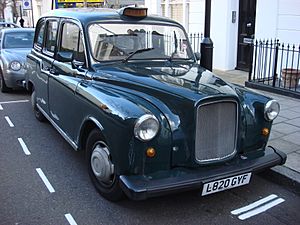Taxi facts for kids
A taxi (also called a taxicab or cab) is a special type of car or vehicle used for public transport. People hire taxis to take them directly to where they want to go. Unlike a bus or train, a taxi doesn't have set stops or a fixed route. It picks you up and drops you off exactly where you need to be. Many big cities around the world have taxis.
When you ride a taxi, it's a bit like having your own car, but someone else does the driving! You just tell the taxi driver your destination, and they take you there. The cost of your ride usually depends on how far you travel. Taxis are often more expensive than other types of public transport, like buses or subways.
Contents
How Taxis Started: A Look Back in Time
The idea of hiring a vehicle to take you places began a long time ago, in the early 1600s. In cities like Paris and London, people could hire horse-drawn carriages. These early "taxis" were controlled by the rulers of those cities. Later, in the 1800s, a safer type of carriage called the Hansom cab became very popular.
The Taximeter: How Taxis Measure Your Ride
What is a Taximeter?
The modern taxi we know today got a big boost from an invention in 1891. A German inventor named Wilhelm Bruhn created the taximeter. This device measures the distance traveled and calculates the fare (the price) for the ride.
The First Modern Taxis
The very first taxi that used a taximeter was the Daimler Victoria. It was built by Gottlieb Daimler in 1897. In the same year, the first company with motorized taxis (cars with engines) started operating in Stuttgart, Germany.
Where the Word "Taximeter" Comes From
The word taximeter comes from French and German words. It means "measuring a tax" or "measuring a fee." This makes sense because the taximeter measures how much you owe for your taxi ride!
Images for kids
See also
 In Spanish: Taxi para niños
In Spanish: Taxi para niños





















